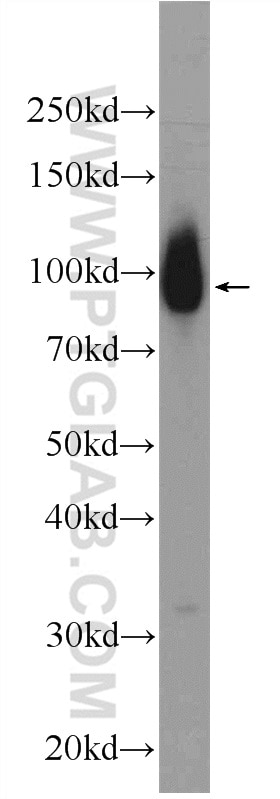- Phare
- Validé par KD/KO
Anticorps Polyclonal de lapin anti-E2F7
E2F7 Polyclonal Antibody for WB, ELISA
Hôte / Isotype
Lapin / IgG
Réactivité testée
Humain et plus (1)
Applications
WB, IF, IHC, CoIP, ELISA
Conjugaison
Non conjugué
N° de cat : 24489-1-AP
Synonymes
Galerie de données de validation
Applications testées
| Résultats positifs en WB | cellules HeLa |
Dilution recommandée
| Application | Dilution |
|---|---|
| Western Blot (WB) | WB : 1:500-1:1000 |
| It is recommended that this reagent should be titrated in each testing system to obtain optimal results. | |
| Sample-dependent, check data in validation data gallery | |
Applications publiées
| KD/KO | See 2 publications below |
| WB | See 11 publications below |
| IHC | See 2 publications below |
| IF | See 3 publications below |
| CoIP | See 1 publications below |
Informations sur le produit
24489-1-AP cible E2F7 dans les applications de WB, IF, IHC, CoIP, ELISA et montre une réactivité avec des échantillons Humain
| Réactivité | Humain |
| Réactivité citée | Humain, souris |
| Hôte / Isotype | Lapin / IgG |
| Clonalité | Polyclonal |
| Type | Anticorps |
| Immunogène | E2F7 Protéine recombinante Ag21599 |
| Nom complet | E2F transcription factor 7 |
| Masse moléculaire calculée | 911 aa, 100 kDa |
| Poids moléculaire observé | 95 kDa |
| Numéro d’acquisition GenBank | BC136366 |
| Symbole du gène | E2F7 |
| Identification du gène (NCBI) | 144455 |
| Conjugaison | Non conjugué |
| Forme | Liquide |
| Méthode de purification | Purification par affinité contre l'antigène |
| Tampon de stockage | PBS avec azoture de sodium à 0,02 % et glycérol à 50 % pH 7,3 |
| Conditions de stockage | Stocker à -20°C. Stable pendant un an après l'expédition. L'aliquotage n'est pas nécessaire pour le stockage à -20oC Les 20ul contiennent 0,1% de BSA. |
Informations générales
E2F7 also named as E2F transcription factor 7 is a 911 amino acid protein, which belongs to the E2F/DP family. E2F7 localizes in the nucleus and mainly forms homodimers and, to a lesser extent, heterodimers with E2F8. E2F7 as a transcription factor involves in various processes such as angiogenesis, polyploidization of specialized cells and DNA damage response. E2F7 mainly forms homodimers and to a lesser extent, heterodimers with E2F8. (PMID: 18194653 )
Protocole
| Product Specific Protocols | |
|---|---|
| WB protocol for E2F7 antibody 24489-1-AP | Download protocol |
| Standard Protocols | |
|---|---|
| Click here to view our Standard Protocols |
Publications
| Species | Application | Title |
|---|---|---|
Cell Death Dis Functional interplay between E2F7 and ribosomal rRNA gene transcription regulates protein synthesis. | ||
Oncotarget The synthetic antihyperlipidemic drug potassium piperate selectively kills breast cancer cells through inhibiting G1-S-phase transition and inducing apoptosis. | ||
Cancer Cell Int E2F1/2/7/8 as independent indicators of survival in patients with cervical squamous cell carcinoma.
| ||
Transl Oncol Comprehensive analysis to identify the RP11-478C19.2/ E2F7 axis as a novel biomarker for treatment decisions in clear cell renal cell carcinoma
|
Avis
The reviews below have been submitted by verified Proteintech customers who received an incentive forproviding their feedback.
FH Umut (Verified Customer) (10-26-2023) | I could not get any signal in the U87 cells.
|
FH Ekaitz (Verified Customer) (05-03-2023) | We have tested this antibody for Chromatin Immunoprecipitation (ChIP) and it showed similar or even higher efficiency than the Santa Cruz antibody (sc-66870) that we have been using until now in the lab.
|
FH Shatovisha (Verified Customer) (12-06-2018) | This antibody always produced two non-specific bands at 40kD and one at 160kD, but could never get the correct sized band with several optimizations and antibody dilutions.
|


